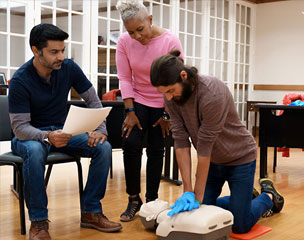-
CPR Classes in Los Angeles
Train for the Moments that Matter
The American Red Cross is dedicated to training people to prepare for, and respond to, emergencies. Our flexible training approach combines a game-changing educational model with the latest science in lifesaving care.
CPR/AED classes in Los Angeles from expert Red Cross Instructors. You will leave with a mastery of lifesaving techniques and the confidence to act when moments matter.
CPR/AED Courses Details

Offered in Los Angeles and available in-person, online or using blended learning (online+ classroom)
Delivered at convenient times in a wide range of locations to accommodate your busy schedule
Upon successful completion of the in-person skills session, receive a 2-year certification that meets OSHA requirements
FAQs
Q: Why Take a CPR Class?
With over 500,000 cardiac arrests occurring each year, CPR training from the American Red Cross can be the difference between life and death. Developed and taught by experts, our training satisfies OSHA, workplace or other regulatory requirements. From personalized learning to interactive scenarios to peer-to-peer learning and hands-on skill practice, you will be prepared to provide care when it's needed most.
Q: What is the best way to learn CPR?
There are many different ways to take CPR classes:
- In-person classes combine lecture with hands-on skills sessions. They're a good choice for those who learn best in traditional classroom settings.
- Blended learning is a mix of online learning and in-person instruction.
- Online CPR classes are a convenient option for those who want to learn on their own schedule and at a location of their choosing. However, since they are taken entirely online, these courses do not allow you to demonstrate skill proficiency to a certified instructor, and therefore do not meet requirements for OSHA certification.
Q: How long is a Red Cross CPR/AED class?
Our CPR/AED course is flexible depending upon training needs and so course length varies depending on the course components taught and the learning method used. Overall, though, courses range from approximately 2 hours to just over hours.
Q: BLS vs. CPR: What's the difference?
While they can understandably be confusing, BLS (Basic Life Support) is not the same as a CPR/AED course. CPR/AED courses are designed for non-medical personnel who want the knowledge necessary to recognize and care for someone in cardiac arrest or who is choking. BLS is designed primarily for healthcare professionals including nurses, physicians, EMS professionals and other healthcare and public safety personnel.
Q: Is there a CPR test?
Yes, but they will differ based on the type of classes you choose. For example, prior to completing an online CPR course, there will be an online skills assessment portion that allows you to review what you've learned and self-test your skill proficiency. However, only in-person and blended learning courses allow you to demonstrate your skills to a certified instructor, which is often a requirement for workplace safety certification.
Q: How long do CPR/AED certifications last?
Upon successful completion of the course, including the in-person skills session, you will receive a 2-year certification.
Q: Can you perform CPR if your certification is expired?
Yes. According to the Centers for Disease Control (CDC), if cardiac arrest happens to someone near you, it's better to act than to do nothing, even if you've never had formal training. Call 911, begin CPR and continue it until medical professionals arrive. Even if your technique isn't perfect, it will give the victim a far better chance of survival. Of course, the best way to save lives is by staying current on your CPR certification. While CPR certifications last two years, your skills can begin to decline within months of training, according to the Red Cross Scientific Advisory Council.

